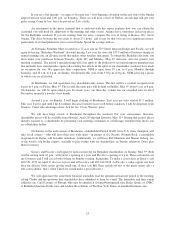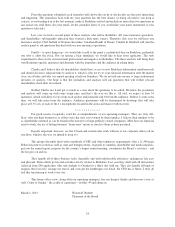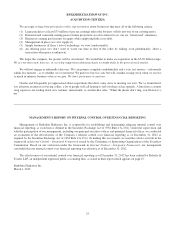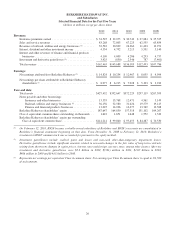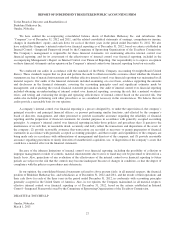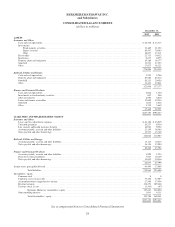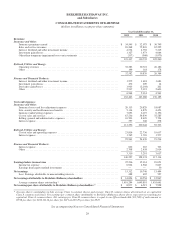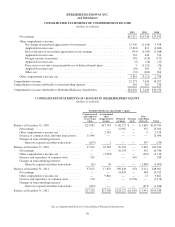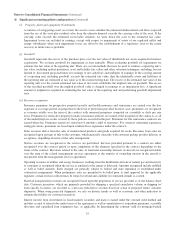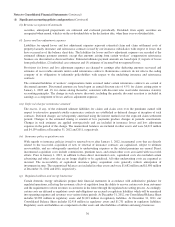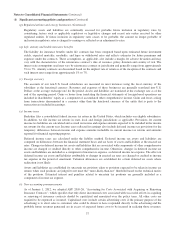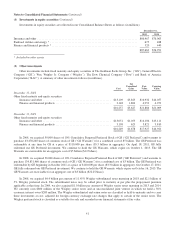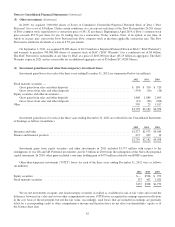Berkshire Hathaway 2012 Annual Report Download - page 35
Download and view the complete annual report
Please find page 35 of the 2012 Berkshire Hathaway annual report below. You can navigate through the pages in the report by either clicking on the pages listed below, or by using the keyword search tool below to find specific information within the annual report.Notes to Consolidated Financial Statements (Continued)
(1) Significant accounting policies and practices (Continued)
(d) Investments (Continued)
In applying the equity method, we record our investment at cost and subsequently increase or decrease the carrying
amount of the investment by our proportionate share of the net earnings or losses and other comprehensive income of
the investee. We record dividends or other equity distributions as reductions in the carrying value of the investment. In
the event that net losses of the investee reduce the carrying amount to zero, additional net losses may be recorded if
other investments in the investee are at-risk even if we have not committed to provide financial support to the investee.
Such additional equity method losses, if any, are based upon the change in our claim on the investee’s book value.
Investment gains and losses arise when investments are sold (as determined on a specific identification basis) or are
other-than-temporarily impaired. If a decline in the value of an investment below cost is deemed other than temporary,
the cost of the investment is written down to fair value, with a corresponding charge to earnings. Factors considered in
judging whether an impairment is other than temporary include: the financial condition, business prospects and
creditworthiness of the issuer, the relative amount of the decline, our ability and intent to hold the investment until the
fair value recovers and the length of time that fair value has been less than cost. With respect to an investment in a debt
security, we recognize an other-than-temporary impairment if we (a) intend to sell or expect to be required to sell
before amortized cost is recovered or (b) do not expect to ultimately recover the amortized cost basis even if we do not
intend to sell the security. We recognize losses under (a) in earnings and under (b) we recognize the credit loss
component in earnings and the difference between fair value and the amortized cost basis net of the credit loss in other
comprehensive income.
(e) Receivables, loans and finance receivables
Receivables of the insurance and other businesses are stated at the outstanding principal amounts, net of estimated
allowances for uncollectible balances. Allowances for uncollectible balances are provided when it is probable
counterparties or customers will be unable to pay all amounts due based on the contractual terms and the loss amounts
can be reasonably estimated. Receivables are generally written off against allowances after all reasonable collection
efforts are exhausted.
Loans and finance receivables primarily consist of manufactured housing and other real estate loans originated or
purchased. Loans and finance receivables are stated at amortized cost based on our ability and intent to hold such loans
and receivables to maturity and are stated net of allowances for uncollectible accounts. Amortized cost represents
acquisition cost, plus or minus origination and commitment costs paid or fees received, which together with acquisition
premiums or discounts, are deferred and amortized as yield adjustments over the life of the loan. Loans and finance
receivables include loan securitizations issued when we have the power to direct and the right to receive residual
returns. Substantially all of these loans are secured by real or personal property.
Allowances for credit losses from manufactured housing and other real estate loans include estimates of losses on loans
currently in foreclosure and losses on loans not currently in foreclosure. Estimates of losses on loans in foreclosure are
based on historical experience and collateral recovery rates. Estimates of losses on loans not currently in foreclosure
consider historical default rates, collateral recovery rates and existing economic conditions. Allowances for credit
losses also incorporate the historical average time elapsed from the last payment until foreclosure.
Loans in which payments are delinquent (with no grace period) are considered past due. Loans which are over 90 days
past due or in foreclosure are placed on nonaccrual status and interest previously accrued but not collected is reversed.
Subsequent amounts received on the loans are first applied to the principal and interest owed for the most delinquent
amount. Interest income accruals are resumed once a loan is less than 90 days delinquent.
Loans in the foreclosure process are considered non-performing. Once a loan is in foreclosure, interest income is not
recognized unless the foreclosure is cured or the loan is modified. Once a modification is complete, interest income is
recognized based on the terms of the new loan. Loans that have gone through foreclosure are charged off when the
collateral is sold. Loans not in foreclosure are evaluated for charge off based on individual circumstances that indicate
future collectability of the loan, including the condition of the collateral securing the loan.
33


